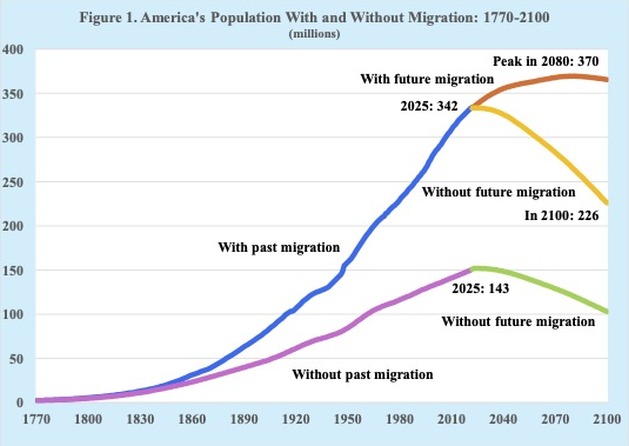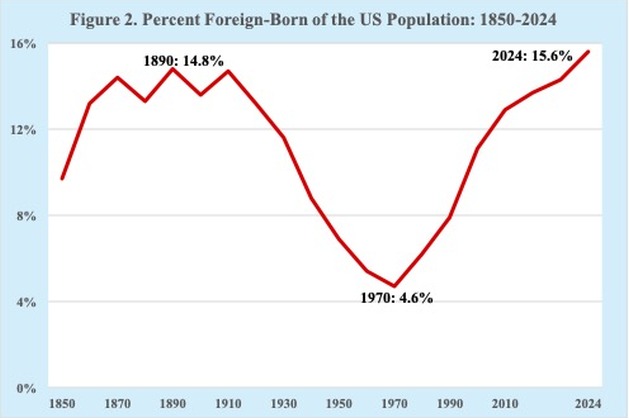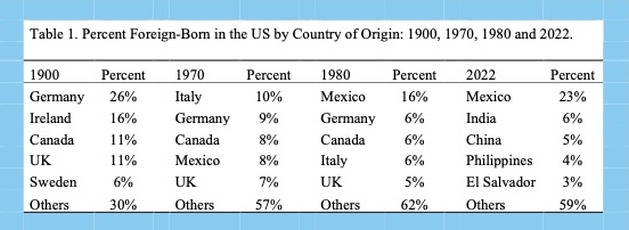PORTLAND, US, Feb 17 (IPS) – Of the approximately 280 million immigrants in the world, the country hosting the largest number is America, the land of immigration. One-fifth of the world’s international migrants reside in the US, with those migrants arriving from nearly every country in the world.
From the country’s very founding in 1776, America’s immigration has greatly influenced the demographic growth, composition and structure of its population.
If immigration to America had ceased after the signing of the Declaration of Independence, when the colonies numbered several million people, its population today would be no more than 143 million. That hypothetical figure is 200 million less than America’s current population of about 342 million (Figure 1).

With respect to America’s demographic growth, immigrants not only add their own numbers to the country’s population but they also contribute to births whose effects are compounded over time.
If future immigration to America were to cease altogether, the US population would stop growing and then after several years, it would begin declining annually throughout the 21st century.
Without future immigration, America’s population is expected to fall below 300 million by 2060. In addition, by the close of the century it would decline further to 226 million, which is two-thirds of its current population size.
However, assuming a continued annual net migration of approximately one million, America’s population is projected to peak at 370 million in the year 2080 and then decline slightly to 366 million by the close of the current century.
With immigration at about one million per year, America’s population is expected to continue representing about 4% of the world’s population throughout the 21st century. Without immigration, America’s population at the close of the century is projected to decline to about 2.6% of the world’s population.
America’s foreign-born resident population in 2024 is estimated at 51.6 million. That figure represents a record high of 15.6% of the country’s total population. If current trends continue, America’s foreign-born population is expected to continue increasing, likely reaching approximately 63 million by the year 2030.
The last time the country’s proportion of the foreign-born reached such a high level was in 1890, when it was 14.8% of America’s population. Furthermore, the current percentage of foreign-born in America of 15.6% is more than three times greater than the record low of 4.7% set in 1970 (Figure 2).

The proportion of births to foreign-born mothers in America has been consistently greater than the percentage of the foreign-born residing in the country. Whereas the proportion of the foreign-born population in America is slightly more than 15%, the proportion of births to foreign-born mothers resident in the US is nearly a quarter, at approximately 23%.
Among the foreign-born resident population in America, about one-quarter of them, or approximately 14 million, are estimated to be unauthorized. Those unauthorized migrants are made up of individuals who overstayed their visa as well as men, women and children who entered the country without authorization.
If all of the unauthorized population were removed from America as the newly elected administration has stated it intends to do, the US population would decline to approximately 328 million.
The ethnic composition of the foreign-born in America has also changed markedly over the past several centuries. Throughout the 19th and most of the 20th centuries, the foreign-born population was predominantly from European countries, e.g., Germany, Ireland, Italy and the UK (Table 1).

In 1900, for example, German immigrants accounted for 26% of America’s foreign-born population, followed by immigrants from Ireland at 16%. By 1970, however, Mexico had moved up among the top five immigrant sending countries, accounting for 8% of the foreign-born. By 1980 Mexico was in first place with 16% of the US resident foreign-born population.
In 2022, the top five countries contributing to America’s foreign-born population were no longer of European origin. The countries of Europe have been replaced by Mexico, India, China, Philippines, and El Salvador, with Mexico accounting for nearly one quarter of the foreign-born in America.
In the remaining decades of the 21st century, the dominant force fueling America’s demographic growth in the future is expected to be immigration. The reason for immigration’s increasing demographic impact on the size, growth and composition of America’s population is the country’s low fertility rate.
America’s fertility rate has declined from nearly four births per woman around 1960 to approximately 1.6 births per woman today. The country’s current fertility rate is well below the needed replacement level of about two births per woman.
Without immigration, deaths in America are expected to outnumber births by around 2033 largely because fertility rates are expected to remain too low for a generation to replace itself. Consequently by 2080, the annual number of deaths in America is expected to be one million more than the annual number of births.
In addition to its effects on the country’s demographic growth and ethnic composition, immigration also impacts the age structure of America’s population. Without continuing immigration, America’s population would be markedly older in the future than currently being projected.
Assuming net immigration continues to be approximately one million per year, the US population’s current median age of 40 years is expected to increase to 42 years by 2050. Also, the proportion of America’s population aged 65 years or older, which is currently 18%, is expected to increase to 23% by 2050. Without immigration, the median age of America’s population is projected to be 47 years by midcentury and the proportion aged 65 years or older is expected to be 26%.
America’s immigrant heritage has been encapsulated in the famous words penned by Emma Lazarus in 1883 that are inscribed on the pedestal of the Statue of Liberty. In her sonnet, The New Colossus, she wrote: “Give me your tired, your poor, Your huddled masses yearning to breathe free, The wretched refuse of your teeming short. Send these, the homeless, tempest-tost to me, I lift my lamp beside the golden door!”.
As it has been throughout the country’s nearly 250-year history, immigration is expected to continue having important consequences on the growth, composition and structure of America’s population throughout the 21st century and beyond.
Joseph Chamie is a consulting demographer, a former director of the United Nations Population Division and author of numerous publications on population issues, including his recent book, “Population Levels, Trends, and Differentials”.



